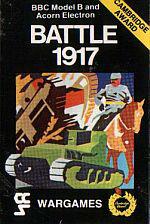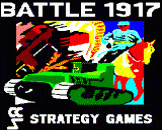Blurb
Mark Lucas won the Cambridge Award with Battle 1917 because it is a highly original wargame. The game is played by two players on a board 21 x 32 showing a map which changes with every game. Each player has 29 pieces including infantry, cavalry, tanks, artillery and a King. The object of the game, like Chess, is to kill the enemy King who is the weakest and slowest piece on the board. The game will appeal equally to all ages and all skills. This is the machine age's answer to Chess.
1. Introduction
This wargame is based on the campaign of the First World War. It requires you to exercise all the skills and tenacity of the Generals during that terrible catastrophe.
2. The Pieces
Maximum Forests Fighting
distance Lakes & Wire Strength Comment
INFANTRY 5 no no +1
CAVALRY 6 no no +2
TANKS 3 no yes +3 flattens forests
& wire
ARTILLERY 3 no no +0 fires shells
KING 2 no no +0 game lost if
killed
3. Minefield
The first piece to pass over a MINEFIELD has a 4:1 chance of clearing it. If the piece in unlucky, the MINEFIELD will explode, destroying the piece.
4. Compass
This is an "on-screen prompt" to help the players.
8 1 2
7 + 3
6 5 4
e.g. KEY 1 to move NORTH, KEY 0 indicates NO MOVE.
5. Fighting Strength
When a piece is moving and meets an enemy in his way, they fight.
Each piece scores a "BATTLE NUMBER" which is a number from 0 to 5 plus his particular FIGHTING STRENGTH.
6. Artillery Fire
The shells may fall exactly on the square required, or fall slightly short, or go slightly over. RANGE 1 should only be used in extreme circumstances as there is a 1:3 chance of self-destruction!
If the shell falls on any piece (enemy or own), or FORESTS or WIRE or MINEFIELD, it is destroyed.
Shells falling "OFF BOARD" or "ON COMPASS" are not shown and shells falling into LAKES just make a splash.
7. King
He is the slowest, weakest piece in the army. As the object of the game is to kill the KING, you should try to keep him out of the way, and well protected.
Never send him through a MINEFIELD, and look out for enemy ARTILLERY sneaking up to ten squares away trying for a "lucky long shot".
8. Tactics
Try to keep the units of four pieces together in formation, rather than leaving some behind.







